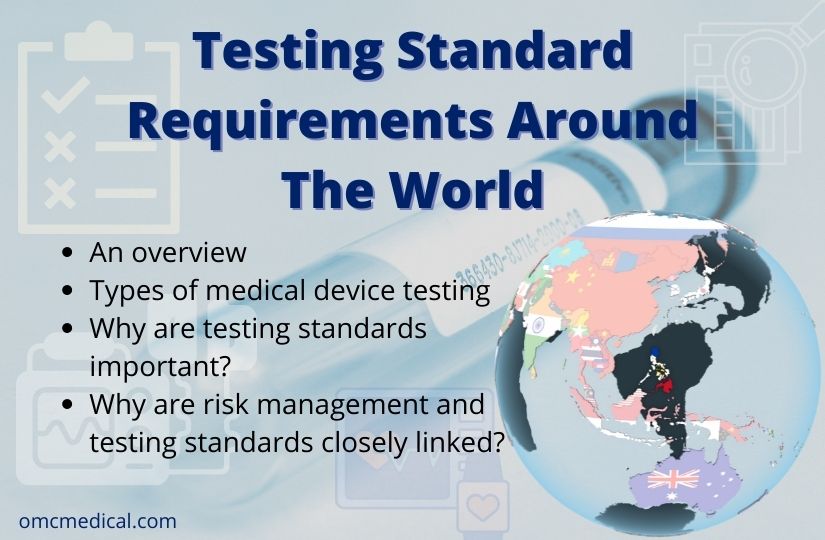Medical device testing standard- an overview
Medical device testing is a crucial step in manufacturing a product. This mandatory process ensures that the medical device is safe and effective. Testing of medical devices proves that the product complies with the standards and regulations of a country.
Moreover, it also sheds light on any product defects. This article discusses the testing requirements and the applicable standards.
Medical device testing applies to all medical devices, in-vitro diagnostic devices, combinational products, and active implantable devices. Some common testing of medical devices is given below:
1. Electrical safety tests
2. Functional safety tests
3. Performance tests
4. Electromagnetic compatibility (EMC) tests
5. Electromagnetic Interference (EMI) tests
6. Immunity Tests
7. Biocompatibility tests
8. Chemical testing
9. Cybersecurity tests (applicable to SaMDs or software that store data)
10. Storage and Transport
11. Ingress Protection
Medical device testing is crucial as the device intended for patient use must be safe. The tests a medical device must undergo depend on the device’s type. To explain further, medical equipment like a ventilator must undergo an electrical safety test.
At the same time, a device such as a cannula requires appropriate biocompatibility tests. Hence, the choice for a practical device test is taken with the help of the medical device’s intended use.
The testing procedure should be logical and must begin with a risk analysis. After identifying the failure mechanisms and hazards associated with a device, testing strategies and processes can be devised to quantify the size of these risks.
As a result, the purpose of a test method and procedure is to offer evidence that the hazards connected with a device are insignificant or, at the very least, acceptable when weighed against the benefits received from its use.
Types of medical device testing
Medical device testing is broadly categorized into physical, chemical/biological and cybersecurity testing. Physical testing involves the tests such as electrical testing, MRI safety, functional safety tests and EMC tests.
IEC 60601 series is a widely accepted technical standard for the safety and performance of electrical equipment. EMC/EMI tests ensure that the overall device is compatible with other medical devices and works optimally in the device environment when subjected to interference and immunity.
Conformance to this standard provides that medical equipment does not create electromagnetic fields that could impair the operation of other devices in the usual environment.
Chemical or biological testing help achieve device compatibility with the surface of the skin. Medical devices that contact skin must comply with the ISO 10993 series- Biological evaluation of medical devices.
For this, the manufacturer must consider the choice of material used compatibility between device materials and the biological tissues, cells, and body fluids. Testing methods like stress, shear testing, and ageing tests are performed so that the final product causes the least quality concerns.
Cybersecurity testing is crucial to medical devices so that risks such as unauthorized access to data and breaches are identified, and their occurrence minimized.
A common standard followed for medical device software is IEC 62304 and ISO27001. IEC 62304 standard specifies the life cycle requirements for medical device software, whereas in ISO 27001 focuses on data and information security.
It should be noted that each of the above standards is closely related to the ISO standard for risk management of medical devices (ISO 14971).
The risks associated with the medical device should be correctly identified, and appropriate tests should be done, proving that the relevant standards are met. Please read our article on global ISO requirements for a better understanding of the ISO standards.
Testing Requirements around the World
To fully comply with the regulations of each country, one must also align with the testing standards accepted within each country. ISO and IEC standards are accepted across the globe.
Compliance with these ensures that the devices can be marketed without any major difficulties. This article discusses the testing standards followed in major medical device markets.
In Europe, close to 80% of electrical and electronic standards follow the various IEC International Standards. Standards for electromedical equipment include IEC 60601 series standards for the requirements for high-frequency surgical instruments, short-wave therapy equipment and so on.
The EU from time to time releases the harmonized standards list which are the most acceptable standards for the EU compliance.
In the US, accepts certain ISO standards however there are a list of recognized consensus standards that the FDA accepts for medical devices in the US. These include ANSI, AAMI, ATSM and so on.
ANSI standards are applicable to a variety of industries like the ISO whereas AAMI testing standards are specific to medical instruments and ATSM standards are specific for materials used in medical devices.
Canada’s list of Recognized Standards for Medical Devices mentions a combination of ISO and ATSM standards. For electromedical compatibility, it accepts CSA standards.
Australia accepts the list of standards referenced in Conformity Assessment Standard Orders (CASO) and Medical Device Standard Orders (MDSO). It is not mandatory but conformance to these standards are recommended.
FAQs
Why are testing standards important?
Testing standards ensure that the medical device is fit for use not just for the patient but also for the healthcare professionals handling them. Most countries do not have stringent requirements for testing standards, but it is recommended that the devices have some form of tests done.
Why are risk management and testing standards closely linked?
Risk analysis is a crucial step in designing a medical device. Certain identified risks can be managed with a minor change in the initial stages of the manufacture and these can be identified with the help of an appropriate test.
Disclaimer: Regulations/legislations are subjected to changes from time to time and the author claims no responsibility for the accuracy of information.






